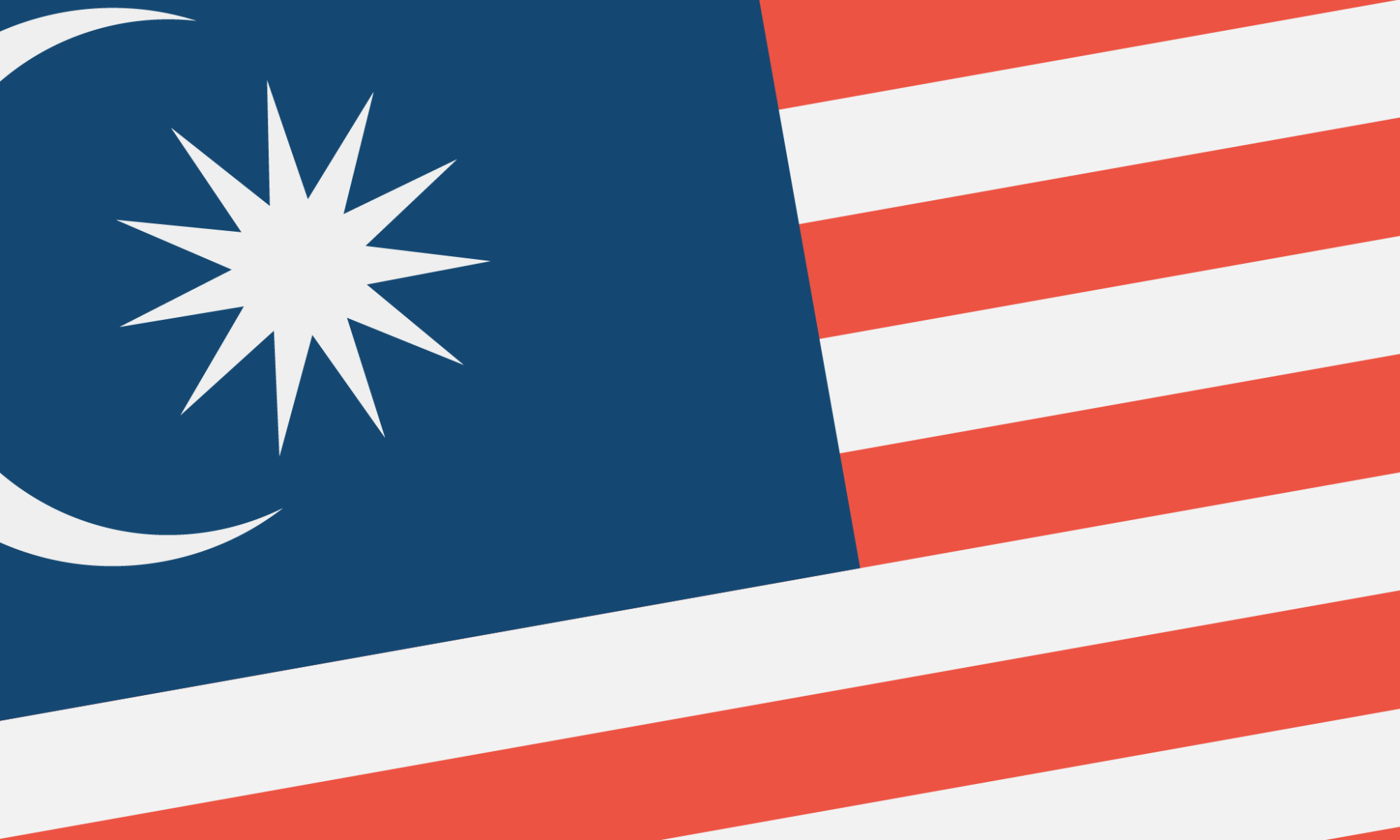Flags in the Indian subcontinent were triangular in nature and referred to as dhwaja in Sanskrit or pataka in Hindi. They are also known through a host of different names: akra, krtadhvaja, ketu, brihatketu, and sahasraketu. They were made of light material to be used in battles to enthuse warriors. Dhwajas were also objects of religious worship in temples, these were called dhwaja stambhas. The use of dhwajas are described in the epic Mahabharata which narrates events that took place between 800 BCE and 700 BCE, but the oldest preserved parts of the document dates to 400 BCE. Here is an interesting essay on the use of flags on the Indian subcontinent by Balakrishna for the Dharma Dispatch site. Sadly, much of this Indian history is patchy at best, no thanks to the climatic conditions of the subcontinent, which makes it hard for historians to unearth the past. Despite this, evidence of the use of flags in ancient times is relatively clear and apparent in epic tales, temples, and paintings.
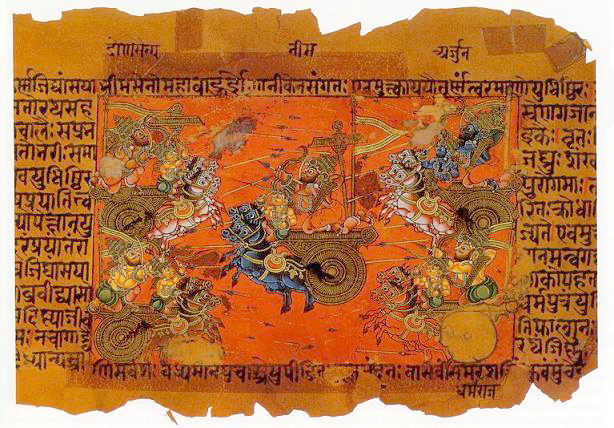
In the book Flags Through the Ages and Across the World, Smith suggest that “we owe to the Chinese two characteristics of flags which are now universal – their lateral attachment to the staff and a focus on the cloth of a flag rather than its staff and finial” (pp. 38–41), the latter being the previous practice in Egypt and Assyria in the use of vexilloids. There is an instance narrated on the Britannica site where the founder of the Zhou dynasty (1046–256BCE) carries a white flag before him, and another instance in 660CE where a minor prince was punished for failing to lower is standard before his superior. Crampton in Webster’s Concise Encyclopedia of Flags & Coats of Arms reveals that the oldest existing silk banner, in the shape of the letter T, was found in 1972 at a burial ground in Hunan province of China and is dated to approximately 200BCE. Barker in The Complete Guide to Flags of the World, page 19, states that it “appears that the pole, and a laterally attached flag, was an Arab influence on the West”. So here we see a relatively clear trend in the adoption of flags starting in the East and moving toward the West. Europe adapted the use of “national” flags much later in the Middle Ages (Crusades) and the Renaissance.
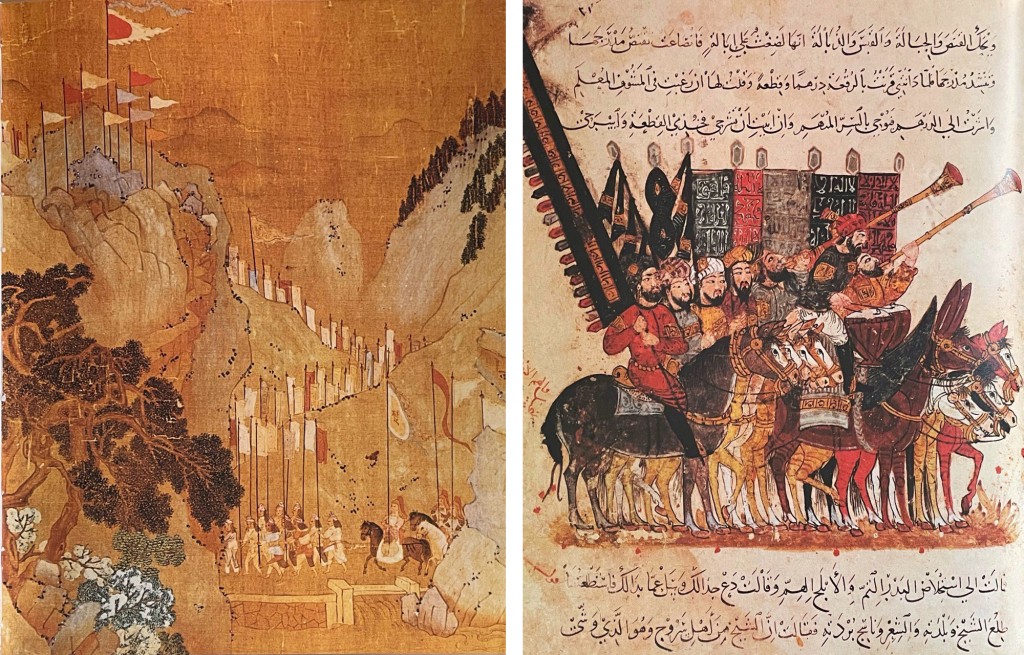
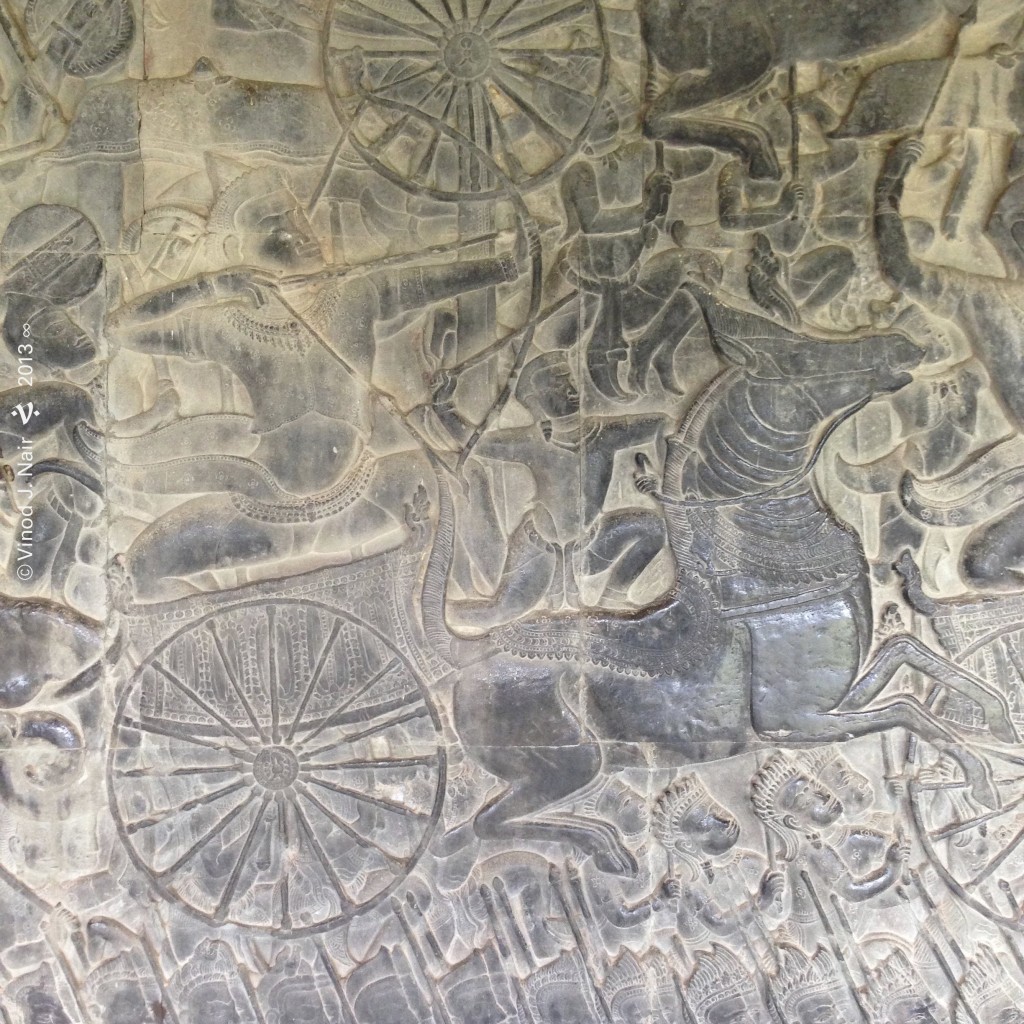
Most books attribute the use of flags to China, thanks to its relatively well preserved and documented history but also its Neolithic practice of sericulture or silk farming, which probably facilitated cloth flags that were light, large, and translucent.
I became interested in flags because of my fascination with school emblems. School emblems in Malaysia have their origins in the discipline of heraldry. Heraldry is a visual identification system previously used to distinguish individuals in battle, but would later symbolise a person’s hereditary line, status, and marriage connections, while Vexillology is the study of “history, symbolism, and use of flags”. Heraldry and vexillology are interrelated disciplines because some areas in their respective fields overlap.
Today when we think of flags, we associate them with symbols of countries or states. We see them as unchanging creations that are meant to last forever. Of course, this is not always the case, what if you are stuck with a flag that looks eerily similar to another country’s (Monaco vs Poland vs Indonesia)? What if you’re stuck with a flag that is too complicated? What if you’re stuck with an unflagtering, flag? What then?

Well, there have been historical and contemporary instances where a country, state or city have changed their flag. Thus, it is possible for changes to occur, but the reason must be significant and popularly supported by its citizens.
Flag of Malaya 1950
In Malaysia (prior to 1963 was known as Malaya), our flag (first adopted in 1950), is by no means unflattering, but the criticism of the “Jalur Gemilang” pertains to its visual similarity to the flag of the United States (first adopted 1777) and the flag of Liberia (adopted 1847). It is also likely wrongly attributed to the flag of the Majapahit empire, according to Dr. Wayan Jarrah Sastrawan, who states that it is a misreading of the Kudadu inscription (Figure 1).
This claim that Majapahit under its first king Raden Vijaya had a red-white flag (like modern Indonesia) comes from a misreading of the Kudadu inscription. In fact it says that it was *enemies* of Vijaya who had the red-white flag in early 1292, before Majapahit was founded https://t.co/JgnXgyLR7V
— Dr Jarrah Sastrawan (@infiniteteeth) September 23, 2021
Figure 1 A tweet from Dr. Wayan Jarrah Sastrawan responding to an oft made claim that the Majapahit empire used a flag of red and white stripes. Sastrawan is a postdoctoral researcher at the École française d’Extrême-Orient in Paris and a research affiliate at the University of Sydney. His research focuses on the historical writing practices of premodern Southeast Asians, specialising in texts written in Malay, Javanese, and Balinese.
Mohamed Hamzah’s design for the Malaya flag competition had its stripes in blue, similar to the Uruguayan flag or today’s Greek flag. The archival documents unearthed and referenced, makes it possible for us to infer the motivations underpinning the amendments of the flag design. More on this later.

In the case of Malaya’s flag, a committee was setup by the appointed Federal Legislative Council (Federation of Malaya Order No.61 of 1949) with the intention of deliberating and proposing a new flag for the federation. Interestingly, and typically, a competition was organised to solicit designs from the public. I feel it is never a good idea to design a symbol that has so much importance connected to it through a competition or a public vote. However, admittedly it is a good way to solicit potential ideas to be debated and improved upon. The committee that was setup by the Federal Legislative Council presented 3 chosen flags from 373 submissions (Figure 12. The Malay Mail was tasked to organise a poll and publish the designs. The majority favoured the design by government architect from Johore, Mohamed Hamzah. The design had 11 horizontal stripes alternately blue and white with the uppermost stripe in blue, in canton a red quarter superimposed with a crescent and star in yellow.
Interestingly, a quarter of the public who were polled wanted a Union Jack included in the flag of Malaya like New Zealand and Australia — talk about a captive mind.

However a cabinet meeting on the 6th of March 1950 of the Federal Legislative Council found “none of the designs were acceptable” and sought a revised design by the 19th of April 1950 (the FOTW site cites a document: BT11/4189 from the Public Record Office at Kew, United Kingdom). The revision to Hamzah’s design were significant in terms of colour placement and in the type of star used but the basic design was somewhat retained.
The document, The History and Chronology of Jalur Gemilang, published by Thinklab and researched by M.R. Nasruddin and Z.N. Zulkhurnain (2012) unearths excerpts of the committee’s meeting minutes. It reveals the term of reference for the committee and their deliberations. These are quite revealing, in one record the committee examines designs provided by Dato Onn (founder of the United Malays National Organisation), which seems to include the colours red, white, blue, two crowns and 9 stars. There seems to be an alignment of views between the chairman and Dato Onn in direction.
Equally revealing is the statement by Dato Onn (Figure 3), which indicates that the flag should denote “…partnership with the United Kingdom”. Thus, the choice of colours red, white and blue, with the exception of yellow, were an attempt at depicting this partnership. These colours were derived from the colours of the Union Jack but were also the colours that appeared the most amongst the state flags.
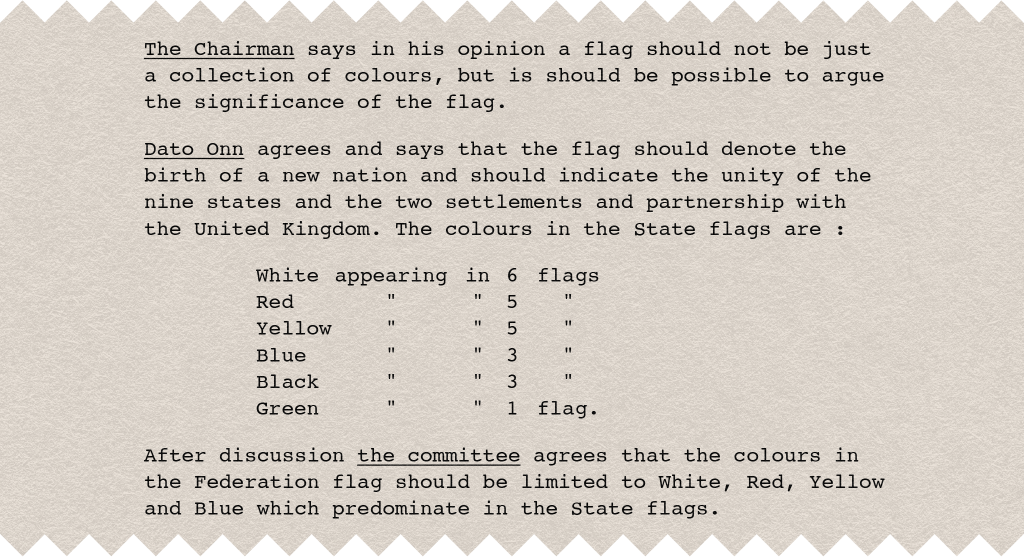
According to the Thinklab document, the final revision tabled at the Federal Legislative Council on the 19th of April 1950 had the revised flag initially displaying the crescent and star in white. Upon the advice of the Sultan of Kedah, the star and crescent would revert to yellow, representing royal sovereigns (p. 21).

This association of Malaya’s flag colours (red, white, and blue) with the United Kingdom is further substantiated by a letter of correspondence, dated 26 June, 1950, between J .D. Heaton Armstrong (Registrar for the College of Arms between 1939–1950) and J.H. Thompson (who was privy to the discussion or close to the High Commissioner of Malaya, Gerard Edward James Gent). I obtained a copy of the letter from the College of Arms, London, but as per my agreement with them, I will not publish the image of the actual letter. However, I can reveal what was said (Figure 4):

From the documents above, there was clearly a concerted effort exerted to maintain a link to the United Kingdom. This is evident from Dato Onn’s statement in the archived committee minutes published by Thinklab (figure 3) and the archival correspondence I obtained from the College of Arms (figure 4), which also records the effort made by the High Commissioner for the UK — possibly Gerard Gent — to convince the Rulers to introduce a representation of the Royal crown into the flag’s design.
From the two documents we can glean the points below:
- narrowing of colours for competition: red, white, blue and yellow
- inclusion of crowns in flag proposal by Dato Onn
- failed persuasion of Malay rulers by UK High Commissioner to include Royal Crown
- Attempt to submit Crescent and Star in white, leaving out yellow
Interestingly, in analysing the correspondence letter between J.H. Thompson and Heaton Armstrong, written a little over a month after King George VI’s approval of the new flag, Thompson makes it a point to note that the crescent and star should be yellow. This would mean that the College of Arms initially recorded it as white and not yellow. If so, it suggests that the federal legislative council during the revision period between 6th of March and 19th April 1950 originally recommended the crescent and star be featured in white and proceeded to submit it to the colonial authorities. If not for the last-minute intervention by the Sultan of Kedah and the Royal Council, this would have been the colours of our flag: red, white and blue.
We must also note the reluctant acquiescence of the admiralty on the choice of the final design due to its similarities to the Liberian and US flags. I dare say they do have a point. It is a little surprising that the Council and committee did not consider it to be a pertinent point and went ahead with it anyway. Flags on vessels are identified at a distance and from a distance, our flag would be difficult to distinguish from the aforementioned countries. It is even difficult to differentiate them when using emojis as Luke Skywalker (Mark Hamill) found out:
So disappointed that #MarkZuckerberg values profit more than truthfulness that I’ve decided to delete my @Facebook account. I know this is a big “Who Cares?” for the world at large, but I’ll sleep better at night. #PatriotismOverProfits ??>? https://t.co/seb2eJMTo6
— Mark Hamill (@MarkHamill) January 12, 2020
Now that we all have had a good laugh at my expense for mistaking a TEENY-TINY flag of Malaysia for a TEENY-TINY Old Glory-the fact remains the same: NO country measures their worth in?(also, I accidentally blundered into a LOAD of Malaysian followers) #HammyHeartsSoutheastAsia pic.twitter.com/SI3nLW80jJ
— Mark Hamill (@MarkHamill) January 14, 2020
Did you know that there was an alternative proposal for the flag of Malaya other than that which was proposed by the appointed and not elected Federal Legislative Council? This flag was named the People’s Flag and was adopted on the 10th of December 1947 by the first ever multiracial coalition party in Malaya: PUTERA-AMCJA. It was a coalition of left-wing parties not favoured by the colonial authorities unlike the individuals appointed to the Federal Legislative Council. This flag was reportedly widely flown in many major cities in 1947, for more on this, you may read the Twitter thread by Fahmi Reza, which features various news articles on the flag:
HARI INI DALAM SEJARAH (10 Disember 1947)
Pada tahun 1947 dah wujud sebuah bendera kebangsaan yang bernama ‘Bendera Rakyat’ yang telah dikibarkan secara rasmi di seluruh Malaya genap 73 tahun dulu pada 10 Disember 1947.
[A THREAD] #SejarahRakyat pic.twitter.com/l4AjpkzQx1
— Fahmi Reza (@kuasasiswa) December 10, 2020
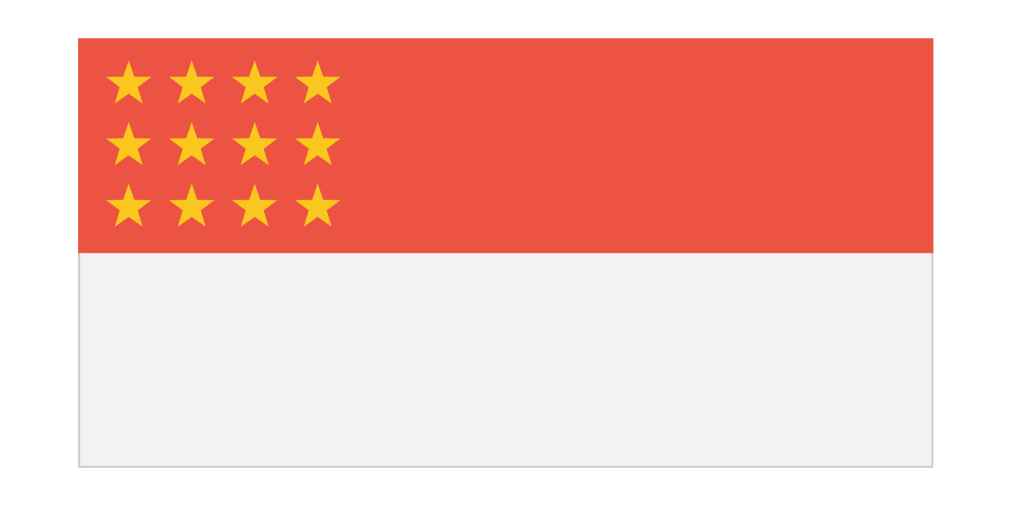
Also note, the people’s flag is more in keeping with the region. Indonesia and Singapore both celebrate a “Common heritage” and are thus in keeping with the five principles of good flag design, “flag designers can choose symbols, colors, and shapes that recall other flags as a powerful way to show heritage, solidarity, or connectedness.”
In conclusion, we can infer with some amount of confidence that flags, as we know them today, originated in what is now China and the Indian subcontinent. The use of flags in the west is a result of influence from the Arabs. The Malaya 1950 flag was based on the design submitted by architect Mohamed Hamzah. While the basic design would remain, there would be significant alteration in the placement of colour. The colours are influenced by the United Kingdom’s Union Jack and the initial revision had the crescent and star featured in white. It would be changed to yellow with the intervention of the Sultan of Kedah and the Royal Council. The similarity to the US flag is likely coincidental, as they were both colonies of the UK and their flag colours are derived from this relationship. Nevertheless, this does not negate the fact that they look similar and the appointed Federal Legislative Council and committee should have recognised this fact, as the admirals did. To this end I constructed a timeline of key events in the creation of the national flag of 1950.

With that we come to the end of this article on origins of flags and of our own flag. I hope this article not only lights a fire in you about flags (vexillology) but also about flag design (vexillography). As a country we can still look into our city flags, many of which do not adhere to the best practices in flag design. Perhaps in my next article I should think about revising a few of our city flags, what say? Comment below.

